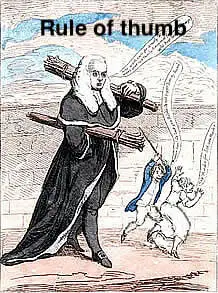A rule of thumb is a means of estimation made according to a rough and ready practical rule, not based on science or exact measurement.
Rule of thumb
What's the meaning of the phrase 'Rule of thumb'?
What's the origin of the phrase 'Rule of thumb'?
In the popular imagination, in England at least, the ‘rule of thumb’ has been said to derive from the belief that English law allowed a man to beat his wife with a stick so long as it is was no thicker than his thumb.
said (wrongly) to be the
origin of the phrase ‘Rule
of thumb’.
That’s not the case. Although it is true that English common law once held that it was legal for a man to chastise his wife in moderation (whatever that meant), the ‘rule of thumb‘ has never been the law in England.
Nevertheless, the myth refuses to die out. In 1782, Judge Sir Francis Buller is reported as having made this legal ruling and in the following year James Gillray published a satirical cartoon attacking Buller and caricaturing him as ‘Judge Thumb’. The cartoon shows a man beating a fleeing woman and Buller carrying two bundles of sticks. The caption reads “thumbsticks – for family correction: warranted lawful!“
It seems that Buller was hard done by. He was notoriously harsh in his punishments and had a reputation for arrogance, but there’s no evidence that he ever made the ruling that he is infamous for. Edward Foss, in his authoritative work The Judges of England, 1870, wrote that, despite a searching investigation, “no substantial evidence has been found that he ever expressed so ungallant an opinion”.
Despite the phrase being in common use since the 17th century and appearing many thousands of times in print, there are no printed records that associate it with domestic violence until the 1970s, when the notion was castigated by feminists. The responses that circulated then, which assumed the wife-beating law to be true, may have been influenced by Gillray’s cartoon or were possibly a reaction to The Rolling Stones’ song ‘Under My Thumb‘, which was recorded in 1966.
The phrase itself has been in circulation since the 1600s. The earliest known use of it in print appears in a sermon given by the English puritan James Durham and printed in Heaven Upon Earth, 1658:
“many profest Christians are like to foolish builders, who build by guess, and by rule of thumb and not by Square and Rule.”
The origin of the phrase remains unknown. It is likely that it refers to one of the numerous ways that thumbs have been used to estimate things – judging the alignment or distance of an object by holding the thumb in one’s eye-line, the temperature of brews of beer, measurement of an inch from the joint to the nail to the tip, or across the thumb, etc. The phrase joins the whole nine yards as one that probably derives from some form of measurement but which is unlikely ever to be definitively pinned down. The Germans have a similar phrase to indicate a rough approximation – ‘pi mal daumen’ which translates as ‘pi [3.14…] times thumb’.
The earliest such ‘measurement’ use that I can find referred to in print is in a journal of amusing tales with the comprehensive title of Witt’s Recreations – Augmented with Ingenious Conceites for the Wittie and Merrie Medicines for the Melancholic. It was published in 1640 and contains this rhyme:
If Hercules tall stature might be guess’d
But by his thumb, the index of the rest,
In due proportion, the best rule that I
Would chuse, to measure Venus beauty by,
Should be her leg and foot:
The ‘rule of leg’ never caught on.
The history of “Rule of thumb” in printed materials
Trend of rule of thumb in printed material over time
Related articles
Related phrases and meanings
Browse more Phrases
About the Author

Phrases & Meanings
A-Z
A B C D E F G H I J K L M N O P Q R S T UV W XYZ
Categories
American Animals Australian Bible Body Colour Conflict Death Devil Dogs Emotions Euphemism Family Fashion Food French Horses ‘Jack’ Luck Money Military Music Names Nature Nautical Numbers Politics Religion Shakespeare Stupidity Entertainment Weather Women Work
How did we do?
Have you spotted something that needs updated on this page? We review all feedback we receive to ensure that we provide the most accurate and up to date information on phrases.
